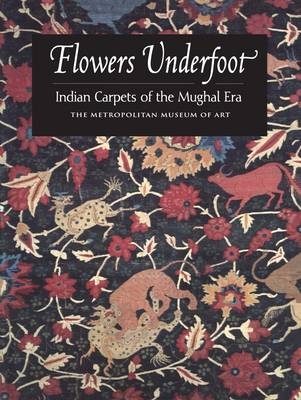
Flowers Underfoot
Indian Carpets of the Mughal Era
Seiten
2013
Metropolitan Museum of Art (Verlag)
978-0-300-19974-1 (ISBN)
Metropolitan Museum of Art (Verlag)
978-0-300-19974-1 (ISBN)
- Titel wird leider nicht erscheinen
- Artikel merken
With the exhibition "Flowers Underfoot: Indian Carpets of the Mughal Era," The Metropolitan Museum of Art paid tribute to India, as the country celebrates its fiftieth year of indepdendence. The exhibition featured works from the sixteenth to the eighteenth century, the period during which Indian carpet weavers produced their most stunning works. Despite their breathtakingly delicate beauty, Indian carpets are little known even to carpet experts, so "Flowers Underfoot: Indian Carpets of the Mughal Era" and its accompanying catalogue are crucial additions to both the study of Indian art and carpet studies.
Indian Carpets are very difficult to study as a group since there are about five hundred surviving pieces, a large number of which are scattered in private collections around the world. Consequently, a long period of research was necessary to gather information on the extant pieces and to have an understanding of this impressive body of material. The exhibition and its catalogue constitute the first in-depth study of Indian carpets and will surely take their rightful place in the history of carpet studies.
The works in the exhibition represent the broad range of carpets produced during the most artistically creative and prolific period of the Mughal Empire. The discussion of carpets in the catalogue roughly follows a chronological development. The earliest works are from the period of the Mughal emperor Akbar (r. 1556-1605), an active patron who is believed to have established the first imperial carpet workshops in India. These carpets combine the dynamism of Akbar's reign with traces of Persian design (due to the large number of Persian artists who immigrated to India at this time). The basic elements of Mughal design were established during this period; they can also be traced in later works. Akbar's son Jahangir (r. 1605-27) succeeded to the throne, and his relatively peaceful period of rule allowed further concentration on the arts. The Persian style continued to dominate court aesthetics during Jahangir's reign, but it became quite different from its Persian prototypes and acquired a distinctly Indian character. It was during the reign of Jahangir's son, Shah Jahan (r. 1628-58) that the flower style in Indian art came into popular use. This aesthetic was characterized by naturalistic flowers , either arranged in rows or against a plain background. The flower style began to dominate not only carpet design but all aspects of Mughal art. [This book was originally published in 1997 and has gone out of print. This edition is a print-on-demand version of the original book.]
Indian Carpets are very difficult to study as a group since there are about five hundred surviving pieces, a large number of which are scattered in private collections around the world. Consequently, a long period of research was necessary to gather information on the extant pieces and to have an understanding of this impressive body of material. The exhibition and its catalogue constitute the first in-depth study of Indian carpets and will surely take their rightful place in the history of carpet studies.
The works in the exhibition represent the broad range of carpets produced during the most artistically creative and prolific period of the Mughal Empire. The discussion of carpets in the catalogue roughly follows a chronological development. The earliest works are from the period of the Mughal emperor Akbar (r. 1556-1605), an active patron who is believed to have established the first imperial carpet workshops in India. These carpets combine the dynamism of Akbar's reign with traces of Persian design (due to the large number of Persian artists who immigrated to India at this time). The basic elements of Mughal design were established during this period; they can also be traced in later works. Akbar's son Jahangir (r. 1605-27) succeeded to the throne, and his relatively peaceful period of rule allowed further concentration on the arts. The Persian style continued to dominate court aesthetics during Jahangir's reign, but it became quite different from its Persian prototypes and acquired a distinctly Indian character. It was during the reign of Jahangir's son, Shah Jahan (r. 1628-58) that the flower style in Indian art came into popular use. This aesthetic was characterized by naturalistic flowers , either arranged in rows or against a plain background. The flower style began to dominate not only carpet design but all aspects of Mughal art. [This book was originally published in 1997 and has gone out of print. This edition is a print-on-demand version of the original book.]
| Erscheint lt. Verlag | 25.6.2013 |
|---|---|
| Zusatzinfo | 145 illus. (108 in color) |
| Verlagsort | New York |
| Sprache | englisch |
| Maße | 229 x 305 mm |
| Gewicht | 1198 g |
| Themenwelt | Kunst / Musik / Theater ► Kunstgeschichte / Kunststile |
| Sachbuch/Ratgeber ► Freizeit / Hobby ► Handarbeit / Textiles | |
| ISBN-10 | 0-300-19974-0 / 0300199740 |
| ISBN-13 | 978-0-300-19974-1 / 9780300199741 |
| Zustand | Neuware |
| Haben Sie eine Frage zum Produkt? |
Mehr entdecken
aus dem Bereich
aus dem Bereich
Buch | Softcover (2024)
Edition Michael Fischer (Verlag)
15,00 €
über 70 Geheimtipps für entspanntes Stricken
Buch | Softcover (2024)
Stiebner (Verlag)
20,00 €
einfach, schnell und mit wenig Material
Buch | Softcover (2024)
Frech (Verlag)
10,99 €


